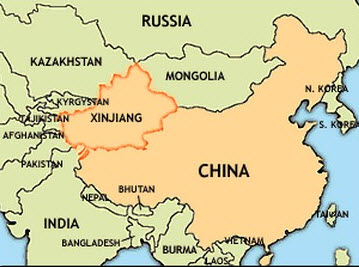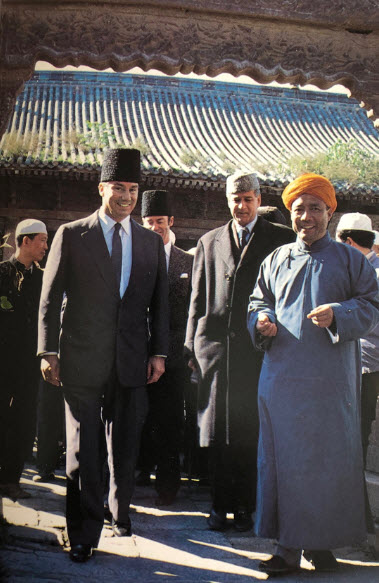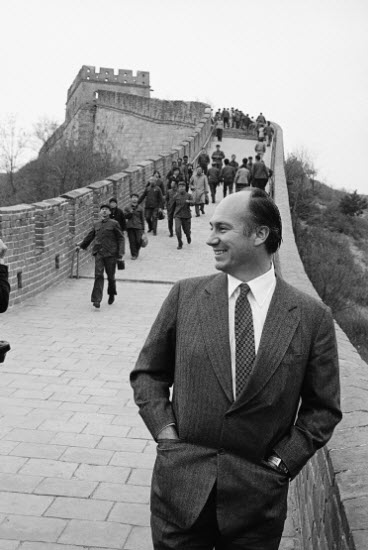Islam has a long history in China dating back to the seventh century when the earliest Muslim traders came to the south-eastern ports as part of the Indian Ocean trade as well as along the Silk Route. In 651, the Prophet’s maternal uncle Sa’ad b. Ali Waqqas (d. 674) led a mission to the court of the Tang Emperor Gaozon (r. 650-683). The emperor “endowed Islam with legitimacy by drawing parallels between Islamic thought and Confucius, and allowed Muslims to practise their faith within the Chinese empire” (Saidula, A Modern History of the Ismailis p 77). Several monuments such as the Great Mosque in the Tang capital Chang’an (present-day Xi’an) date to this early period.

Muslims of China are generally divided into two groups. The first group consists of descendants of Arab, Persian, and Mongol traders who married Chinese women and settled in small communities around a central mosque; they are known as the Hui.
The second group consists of Muslims belonging to minority communities whose homelands are located in the territories of the former Soviet Union, such as the Tajiks, the Uzbeks, and Kazakhs. They are predominantly Sunnis with the exception of the Tajiks in Xinjiang region (officially Xinjiang Uygur Autonomous Region), the westernmost part of the country, who follow the Shia Ismaili interpretation of Islam. Xinjiang was once the hub of the Silk Road and the region through which Buddhism, Christianity, and Islam entered China. Sufism also has a long history in China since the seventeenth century and has played an important role in sustaining Islam for many centuries.

Although the history of the Ismaili tradition in Xinjiang is obscure, the religious rituals open to observation as well as the Persian language texts that are referenced confirm their origin in the tradition of Nasir-i Khusraw (d. ca. 1077), suggesting a history stretching over a millennium.
According to popular legends, “Nasir-i Khusraw led a mission into the region with four of his close disciples, namely Sayyid Hassan Zarrabi, Sayyid Surab Wali, Sayyid Jalal Bukhari, and Jahan Malikshah. He instructed them to settle down and continue the Ismaili da’wa among the new converts” (Saidula, A Modern History of the Ismailis p 77). Many pirs in Xinjiang claim descent from those early Ismaili preachers.
The first jamatkhana was built in Tashkorgan around the end of the nineteenth century with the help of an official envoy from Imam Sultan Muhammad Shah. “The name of the envoy is unclear. Some suggest it was Samad Shah, the British agent in Tashkorghan, while others think it was Pir Sabzali, the envoy sent to Xinjiang by Sultan Muhammad Shah in the 1920s” (Saidula, A Modern History of the Ismailis p 92 n 17).
The few existing written communications “from an Imam addressed to the Ismaili community in Xinjiang province were the farmans of Imam Sultan Muhammad Shah. The last of such farmans, nominating five mukhis in Xinjiang, was received in 1948, just before the closing of the border by the Chinese” (Saidula, A Modern History of the Ismailis p 81).
The government “kept religious institutions closed for over three decades, only allowing some limited practices to resume after the death of Chairman Mao [d. 1976]. By the early 1980s the regime had rectified its past intolerant attitude towards religion by removing the outright ban on all religious practices … During the short-lived period of leniency, many damaged and appropriated places of worship were repaired and restored to their original purpose. The state even initiated various restoration projects, and many abandoned jama’atkhanas benefited from this opportunity, with the result that the number of functioning jama’atkhanas increased to over 40, although the number of worshippers attending religious congregations barely increased in the same period” (Saidula, A Modern History of the Ismailis p 83).
Mawlana Hazar Imam is the only known Ismaili Imam to have visited Xinjiang province.


Sources:
Amier Saidula, “The Nizari Ismailis of China in Modern Times,” A Modern History of the Ismailis Edited by Farhad Daftary, I.B. Tauris in association with The Institute of Ismaili Studies, London, 2011
Michael Dillion “Islam in China,” The Muslim Almanac, Gale Research Inc. Detroit, 1996
